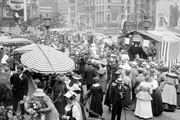Italians have been a part of New York since forever. The first one to arrive, in 1635 according to the registries, was called Pietro Cesare (Peter Caesar in the American documents). He bought a farm in Brooklyn (what is now Fort Green Park) and grew tobacco.
Ever since then, Italian immigrants grew to be one of the most influential ones in New York City. They provided some of its most famous institutions -- Little Italy, the mafia and pizza.

Italian presence in New York was anecdotic until halfway through the 19th century. The revolutionary ebbs and flows of the Risorgimiento made thousands of architects, teachers, lawyers and young university students (all of them involved in the elitist movement for the Italian unification) flee their country and seek better pastures in the New World.
They settled among the other great Catholic community in New York, the Irish, around Bleecker street, provoking rivalries but not rejection. The Irish presence in that area had been acknowledged by the Pope Pious VII, who dedicated the red-brick church in Prince Street to St. Patrick.
In retaliation, the Italians erected a bigger one, with an enormous, pseudo-Gothic ceiling rose and exits to three streets (Houston, Sullivan and Thompson). They dedicated it to one of their own (albeit born in Portugal) saints, so northern that it actually belonged to the Austrian Italy -- St. Anthony of Padua.
Its officiating ceremony, in 1866, was the baptism of an Irish girl called Elizabeth Nelly. Which gives us an idea of the good relationship between both communities.
By then the Italian population had earned the respect of New Yorkers. The 39th Regiment of the New York Infantry, which fought in the Civil War, was known as the Garibaldi Guard and answered to a slogan from Giuseppe Mazzini: "Dio e il popolo".

An Italian called Luigi Palma di Cesnola ran the Metropolitan Museum. The Italian press, impregnated with the values from the Risorgimiento, was cultured, nationalist and abolitionist. By the end of the century there were less than 15,000 Italian citizens in New York, but they were an influential and illustrated minority.
Then, between 1880 and 1890, another Italy arrived in New York.
In just a single decade, over 300,000 day laborers from the South of Italy bursted into a city which had about 1.2 million inhabitants. They brought with them a woe-proof joy, as well as institutions like the mafia, the padrone (the man who would enslave them in exchange for bringing them to New York), and the Italian campanilismo -- a tiny neighborhood-based nationalism that forever changed the outlook of the city. The North End of Mulberry Street and Mott Street was for the Napolitans, the South end of Mott was for the Calabrians and Prince Baxter was for the Sicilians.
By 1890, according to official data from the Congress, 90% of New York's laborers spoke Italian (or, more likely, a dialect) and every year, come September 19, the Italian National Holiday of St. Genaro was celebrated.
By the 20th century, Italy had a firm grip on New York -- there were five mafia families (the most famous ones were the Genovese and the Gambino) and Little Italy was bursting with a new form of Italian culture.